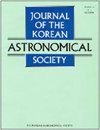CONSTRAINING COSMOLOGICAL PARAMETERS WITH IMAGE SEPARATION STATISTICS OF GRAVITATIONALLY LENSED SDSS QUASARS: MEAN IMAGE SEPARATION AND LIKELIHOOD INCORPORATING LENS GALAXY BRIGHTNESS
IF 0.8
4区 物理与天体物理
Q3 ASTRONOMY & ASTROPHYSICS
引用次数: 4
Abstract
Recent large scale surveys such as Sloan Digital Sky Survey have produced homogeneous samples of multiple-image gravitationally lensed quasars with well-defined selection effects. Statistical analysis on these can yield independent constraints on cosmological parameters. Here we use the image separation statistics of lensed quasars from Sloan Digital Sky Survey Quasar Lens Search (SQLS) to derive constraints on cosmological parameters. Our analysis does not require knowledge of the magnification bias, which can only be estimated from the detailed knowledge on the quasar luminosity function at all redshifts, and includes the consideration for the bias against small image separation quasars due to selection against faint lens galaxy in the follow-up observations for confirmation. We first use the mean image separation of the lensed quasars as a function of redshift to find that cosmological models with extreme curvature are inconsistent with observed lensed quasars. We then apply the maximum likelihood test to the statistical sample of 16 lensed quasars that have both measured redshift and magnitude of lens galaxy. The likelihood incorporates the probability that the observed image separation is realized given the luminosity of the lens galaxy in the same manner as Im et al. (1997). We find that the 95% confidence range for the cosmological constant (i.e., the vacuum energy density) is 0.72 ≤ Ω Λ ≤ 1.0 for a flat universe. We also find that the equation of state parameter can be consistent with ?1 as long as the matter density m . 0.4 (95% confidence range). We conclude that the image separation statistics incorporating the brightness of lens galaxies can provide robust constraints on the cosmological parameters.用引力透镜SDSS类星体的图像分离统计约束宇宙学参数:考虑透镜星系亮度的平均图像分离和似然
最近的大规模调查,如斯隆数字巡天,已经产生了具有明确选择效应的多图像引力透镜类星体的均匀样本。对这些进行统计分析可以得出对宇宙学参数的独立约束。本文利用斯隆数字巡天类星体透镜搜索(SQLS)中透镜类星体的图像分离统计来推导宇宙学参数的约束条件。我们的分析不需要知道放大偏差,这只能从类星体在所有红移时的光度函数的详细知识中估计出来,并且在后续观测中考虑到对暗透镜星系的选择对小像分离类星体的偏差进行确认。我们首先利用透镜类星体的平均像差作为红移的函数,发现具有极端曲率的宇宙学模型与观测到的透镜类星体不一致。然后,我们将最大似然检验应用于16个透镜类星体的统计样本,这些类星体都测量了透镜星系的红移和星等。似然包含了在给定透镜星系光度的情况下,以与Im et al.(1997)相同的方式实现观测到的图像分离的概率。我们发现宇宙常数(即真空能量密度)的95%置信范围为0.72≤Ω Λ≤1.0。我们还发现,只要物质密度为m,状态参数方程就可以与?1一致。0.4(95%置信范围)。我们得出结论,包含透镜星系亮度的图像分离统计可以为宇宙学参数提供强大的约束。
本文章由计算机程序翻译,如有差异,请以英文原文为准。
求助全文
约1分钟内获得全文
求助全文
来源期刊

Journal of the Korean Astronomical Society
地学天文-天文与天体物理
CiteScore
1.30
自引率
10.00%
发文量
0
审稿时长
>12 weeks
期刊介绍:
JKAS is an international scientific journal publishing papers in all fields of astronomy and astrophysics. All manuscripts are subject to the scrutiny of referees. Manuscripts submitted to JKAS must comply with the ethics policy of JKAS. Six regular issues are published each year on February 28, April 30, June 30, August 31, October 31, and December 31. One year''s issues compose one volume.
 求助内容:
求助内容: 应助结果提醒方式:
应助结果提醒方式:


